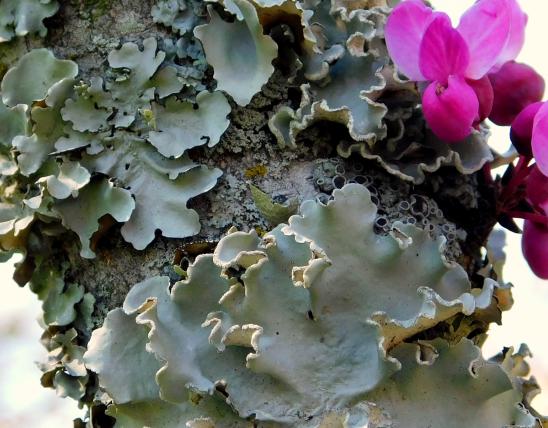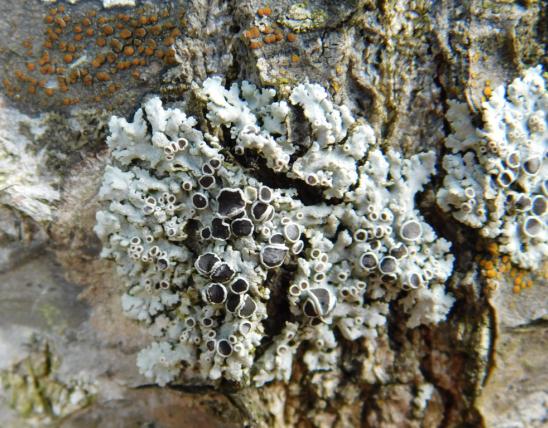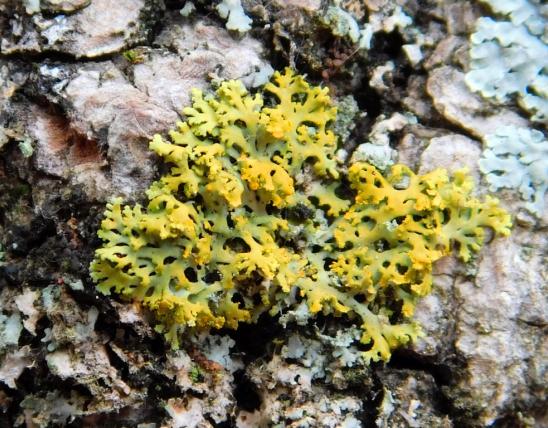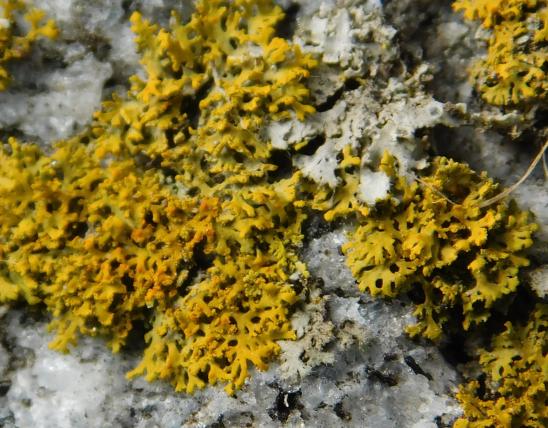
The rock greenshield lichen is a medium to large, green foliose lichen. Common and widespread in eastern North America, it grows on rocks and is especially characteristic of dry, igneous woodlands.
Looking more closely at this species, you’ll often notice pustulae (which resemble coarse isidia — rounded, granular, tiny bumps) forming on the upper surface, making it look rather crusty, textured like the surface of a head of broccoli. The surface of the lichen is dull to rather shiny, smooth on the outer, younger parts and wrinkled in the central, older parts.
Greenshield lichens (Flavoparmelia ssp.) are named for their yellowish-green color. The lobes are broad and rounded, the tips rather flat against the substrate. The undersurface is black, with a narrow zone of brown along the margins. Like other foliose lichens, greenshield lichens grow outward from a central point and have a branching, lobed structure. They have a definite lower surface.
A lichen is an organism that results when a fungus species and an algae species join together. Although the relationship between the fungi and algae is quite intimate and integrated, the lichen that is formed does not much resemble either of the components. Learn more about lichens on their group page.
Similar species: Missouri has two other species of Flavoparmelia:
- The common greenshield lichen (F. caperata) looks very similar, but it grows in sunny places on tree trunks, almost never on rocks; also, instead of coarse, isidia-like pustulae, it bears fluffy or dusty-looking soredia in irregularly shaped patches (soralia) scattered on the surface, and it has an overall dull appearance.
- Another relative, F. rutidota, lives on Missouri’s dry limestone or dolomite cliff faces; listed as a Missouri species of conservation concern, this rarely seen Missouri lichen grows on ancient red cedar trees clinging to cliff faces at Vilander Bluff Natural Area in Crawford County. It does not form soralia, isidia, or pustulae, but it commonly forms apothecia (cups).
Diameter: typically to about 2 to 4 inches; 6 inches is about the maximum. Lichens begin as tiny spots, but groups of them may grow to cover several square inches.
Statewide.
Habitat and Conservation
Habitat can be very helpful for identifying lichens, and this is a great example. The rock greenshield lichen looks very much like the closely related common greenshield lichen, but true to its name, it grows on rocks (only occasionally on tree bases), while the common greenshield lichen is almost always found on wood (bark) (almost never on rocks).
Even the type of rock is important for lichens, because rocks differ in their chemistry. The rock greenshield is most common on sandstone and other neutral rocks, which foster a mildly acidic habitat, and not on limestone or dolomite, which are calcareous rocks that are mildly alkaline.
Status
Of Missouri’s 3 species of greenshield lichens, the rock greenshield and common greenshield lichens are both common. The third, F. rutidota, is listed as a Missouri species of conservation concern.
Missouri’s lichen populations deserve broader and deeper study.
Life Cycle
Lichens can reproduce sexually (via spores) or vegetatively (asexually).
Sexual reproduction, via cuplike structures called apothecia, which give off spores, is not very common in this genus, so you are not likely to see many cup or bowl-shaped apothecia in most greenshield lichens.
But vegetative reproduction, via tiny packets of the lichen that break away easily, is common in this genus. Some species produce soredia and some produce isidia (or, in this case, isidia-like pustulae); a lichen species generally does not produce both types, so being able to distinguish between soredia and isidia helps with identification.
The rock greenshield produces pustulae (which look like rounded, granular, tiny bumps) that form and break open at the top to release packets of the fungus and algae that can begin a new lichen elsewhere.
This lichen can also reproduce when portions of the lichen get broken off and are transported to a new location.
Human Connections
Lichens contribute to a beautiful landscape. How many times do hikers take a rest on a rocky outcrop, admiring the woods or looking off into the distance, yet find themselves absently marveling about the beautiful green lichens growing lavishly on their rocky perch? Something would seem awfully wrong if lichens were to disappear.
When lichens do disappear, it’s often a sign something is indeed wrong. Because lichens, with their soft, absorbent tissues, are extremely sensitive to air pollution, they are good indicators of air quality. In parts of the United States, they disappeared due to acid rain. Scientists use lichens as sentinels of environmental health.
The genus name Flavoparmelia means “green shield.” “Parma” was the name of a type of small shield used in ancient times by Roman soldiers (they named it after the Italian city of Parma, well-known for its cheese and ham, both called Parmesan). The Romans had special words for their various types of shields, and many of these words endure in scientific terms. Here are a few more:
- One shield used by the Romans was the large, round clipeus, which gave us the name for a certain plate on the face of insects (male carpenter bees, for example, have a white clypeus, and the clypeus of a cicada looks like the grille of a 1940 Chevy truck).
- The Romans’ large shield, called a scutum, has come to us in many ways, such as in the word scute (one of the plates that make up the shell of a turtle) and scutellum, a certain plate on the backs of true bugs, flies, and other insects (in stink bugs, it’s the big triangular plate in the middle of the back).
Ecosystem Connections
Lichen moth caterpillars (such as the painted lichen moth and the black-and-yellow lichen moth) feed on lichens, and so do lichen grasshoppers, which live in Missouri’s glades. Both the caterpillars and lichen grasshoppers are camouflaged to blend in perfectly with lichen-covered rocks.
Foliose lichens in the genera Flavoparmelia and the related genus Parmelia are some of the favorite lichens used by birds to camouflage their nests.
Many animals have markings and coloration that helps them blend in with the mottled background of lichen-covered rock. Examples include the prairie lizard and the eastern collared lizard, whose mottled gray-tan back and minty green legs blend in beautifully with the lichen-covered rocks of its glade habitat.
Lichens are pioneer organisms. Over time, lichens that live on rocks gradually chemically degrade the minerals that compose the rock, slowly breaking down (weathering) the rock. This contributes to the development of soils. In places where the landscape is almost totally bare rock, lichens begin the process of ecological succession. Once soils are created, mosses, grasses, and other small plants can become established. As soils are built up, these are followed by a succession of communities of larger plants such as shrubs and trees.










Mosses, liverworts, hornworts, and lichens seem rather similar, but these organisms are in very different groups. Mosses, liverworts, and hornworts are small, low plants usually found in damp habitats. Unlike more familiar plants, they lack veinlike structures and do not produce flowers or seeds — instead, they produce spores. Meanwhile, lichens are not plants at all: they are a collection of different fungi that have photosynthetic algae living within their tissues.





























